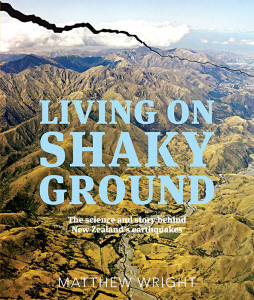Book Reviews » Living on Shaky Ground
The science and story behind New Zealand’s earthquakes
Written By Matthew Wright
Random House
RRP $50
As a child growing up in various parts of New Zealand I never experienced an earthquake until I was married with a young son. We were living at Paekakariki, right slap bang on a major fault line – as I found out later – when we were hit by a biggie in the middle of the night. Things fell from shelves as we headed for the back door, with a wee baby in my arms. Terrifying stuff.
Reading Matthew Wright’s comprehensive book “Living on Shaky Ground,” now I know why I’d never experienced an earthquake before this. The simple reason is … there weren’t any!
Following the infamous Napier earthquake of 1931 (magnitude 7.8), the only others of significance were in 1934 (magnitude 7.6) and 1942 (magnitude 7.2), both in the Wairarapa. Then out of the blue, 26 years later, the big one of Inangahua (magnitude 7.1) struck, followed by another biggie in 1987, this time in Edgecumbe. Things appeared to settle again until Christchurch was hit in September 2010 (magnitude 7.1), followed by a series of powerful aftershocks in the area as well as other biggies in Seddon, Eketahuna and Hawke’s Bay since then.
Not only does the book devote detailed analysis of each significant event, in particular the Napier and Christchurch events at length, it also explores the reasons why earthquakes occur, why more in some regions than others, the historical records dating back to pre-European history, the work of seismologists and their technology.
The book is very readable. An interesting story, it also serves as a valuable reference book and text book for the academic. Supported by many wonderful photographs, many of them historic and maps. This would also make an ideal coffee table book. When I think back to Professor McKenzie and his work on earthquakes for Geography1 at Victoria University in 1967, I can’t help but think how much a book such as this would have made the subject easier – the Kaikoura Orogeny, the Hikurangi Trough, a subducting Pacific Plate and the Australian Plate are suddenly clearly explained. All of which makes me wonder why I now own a home which sits slap, bang on another fault line!

